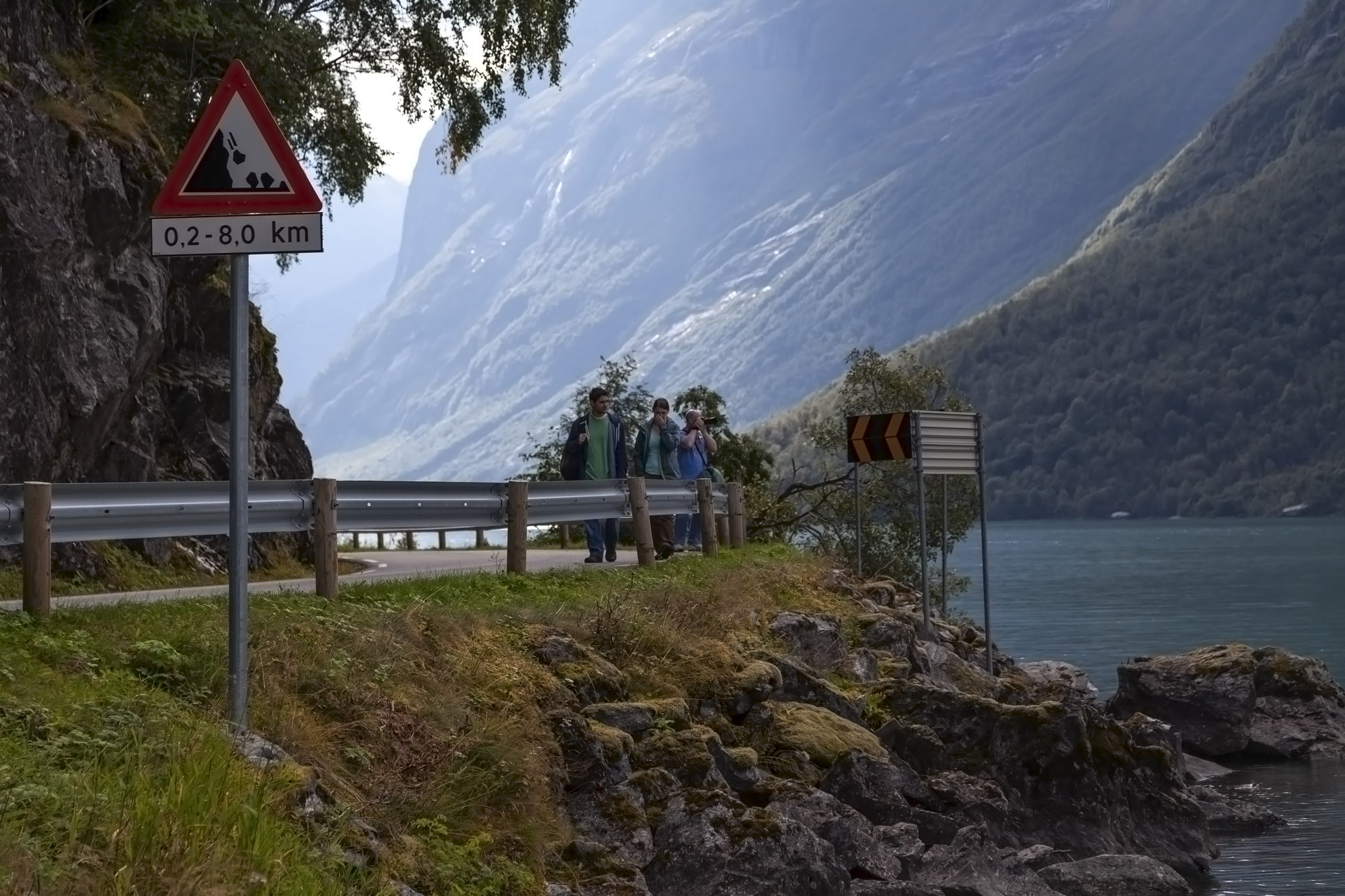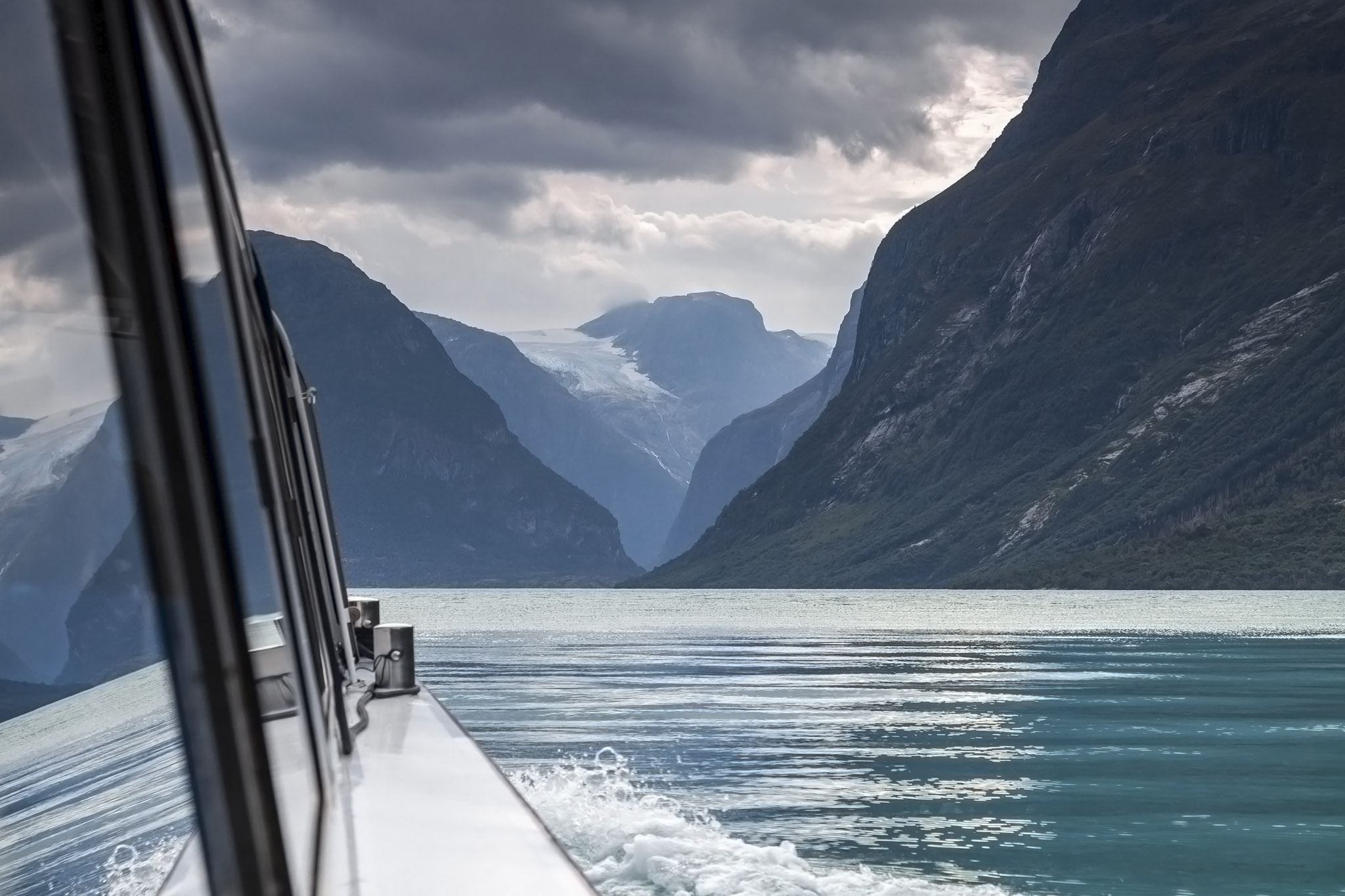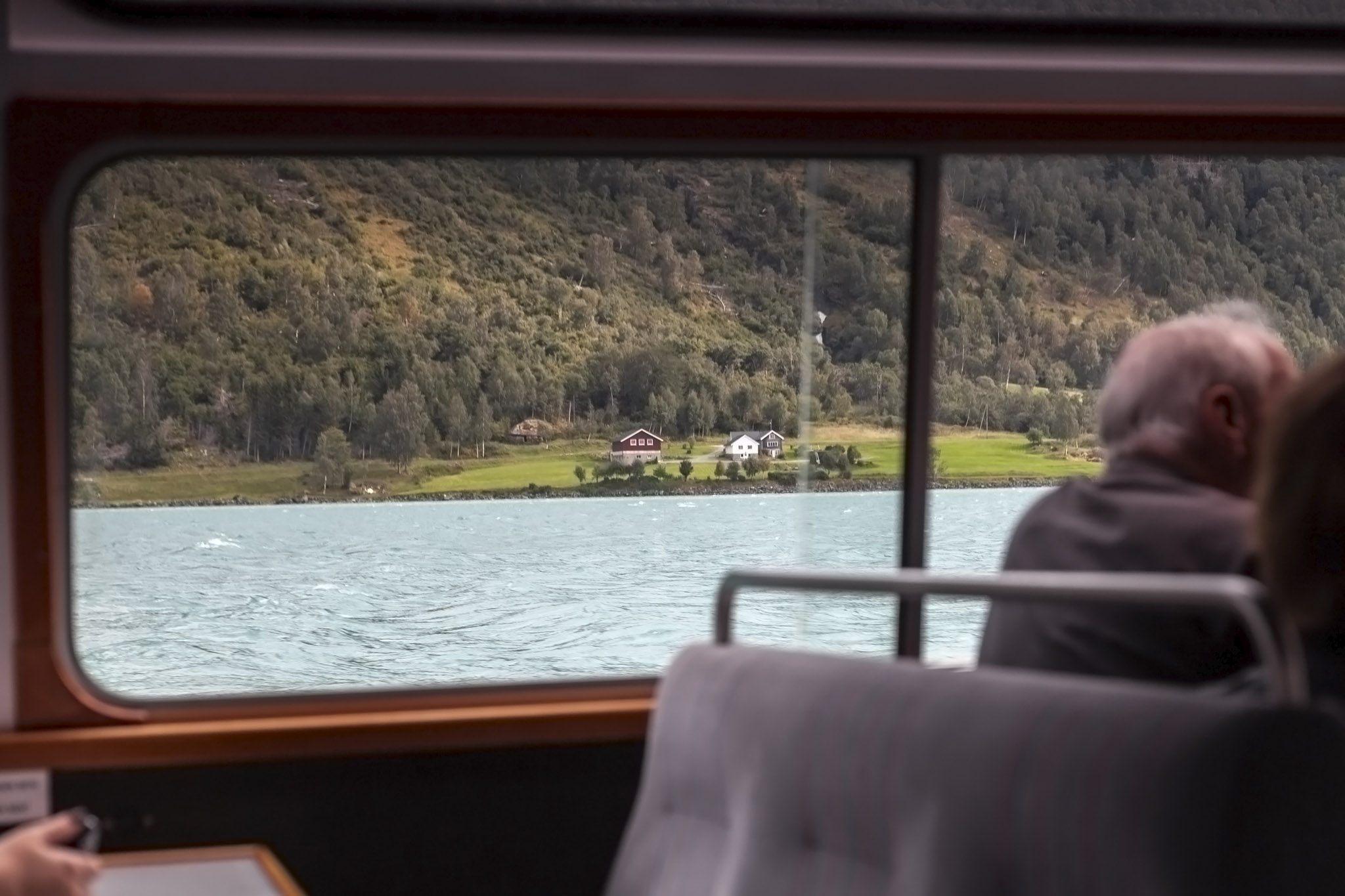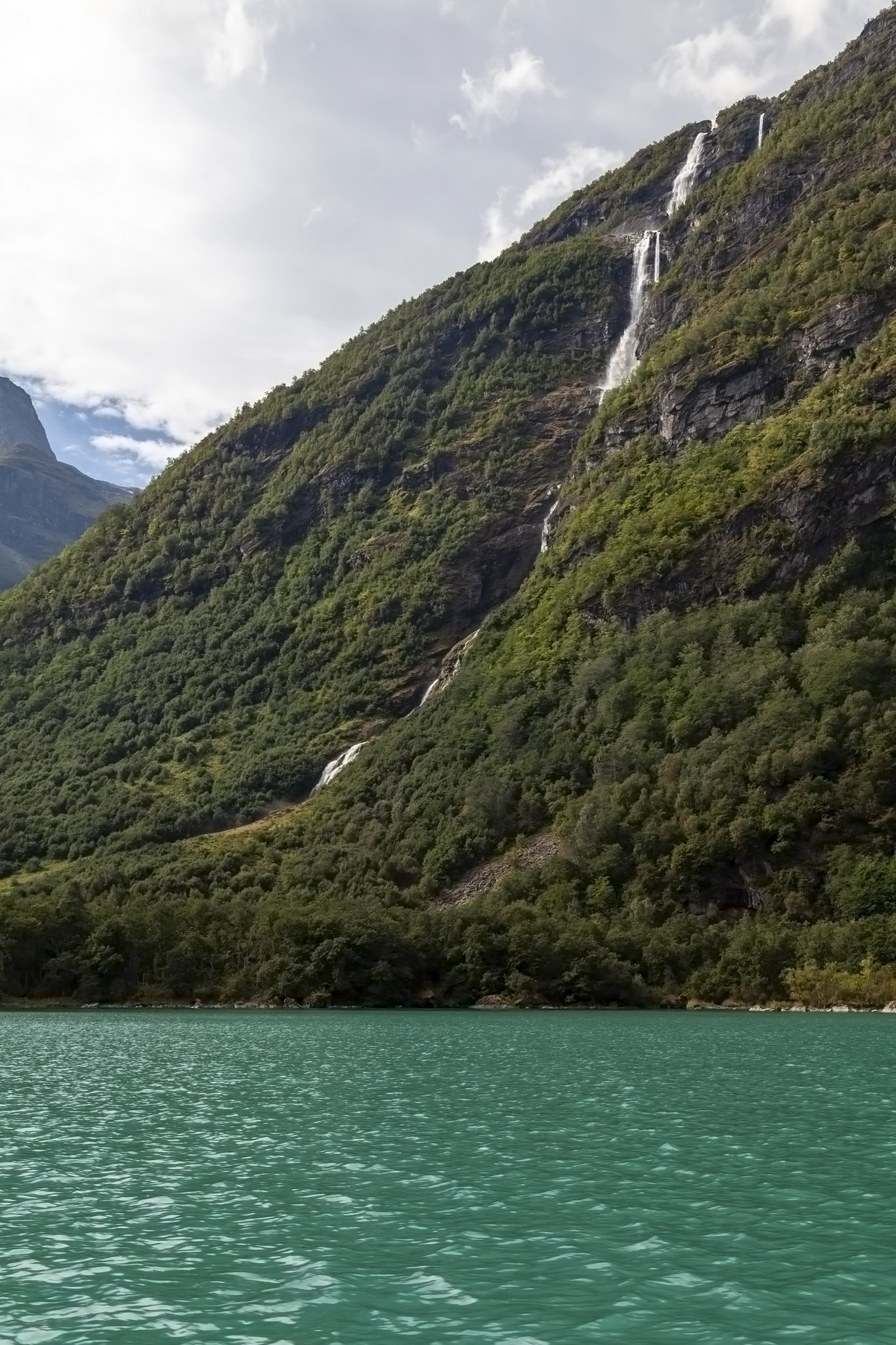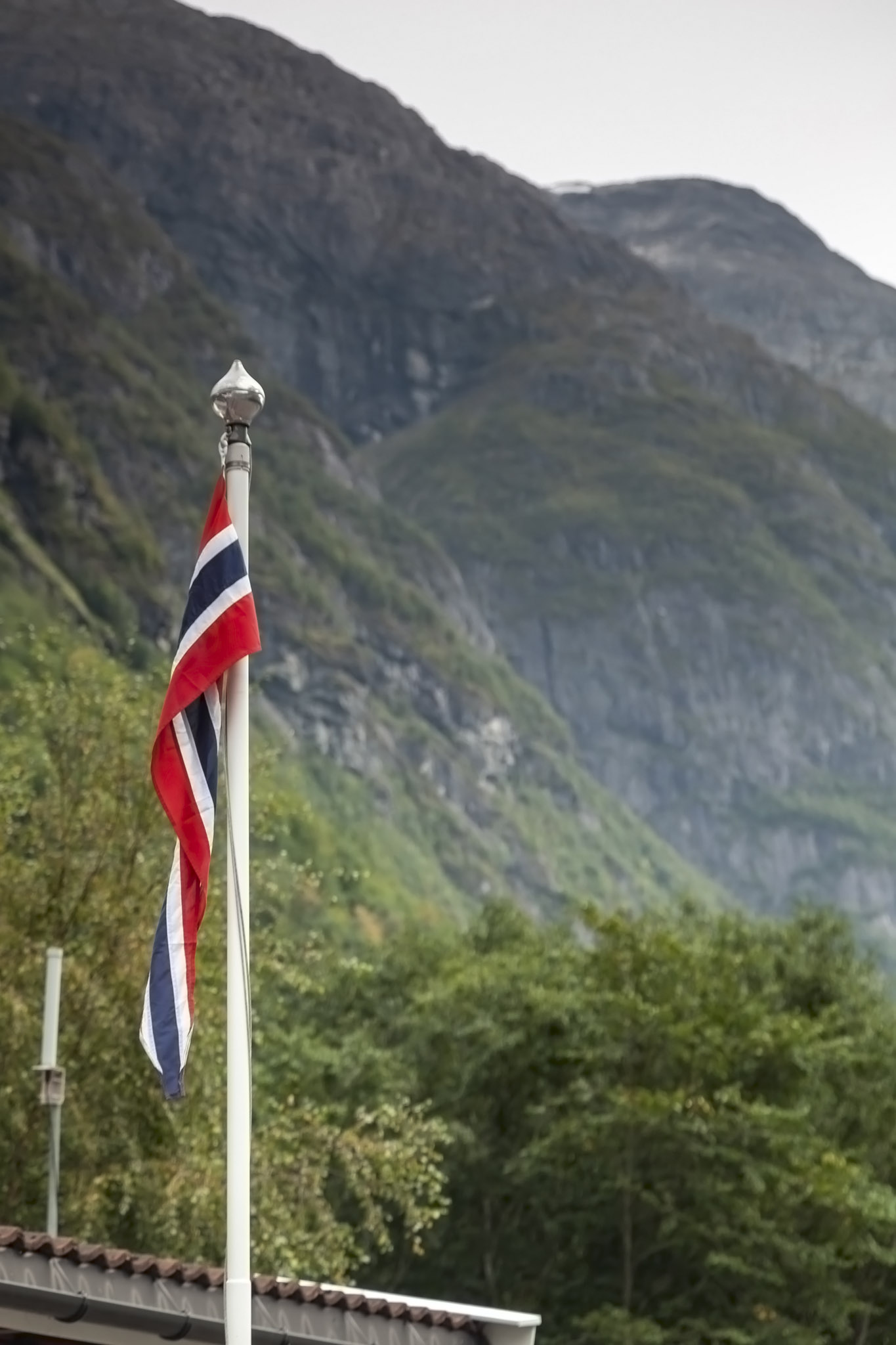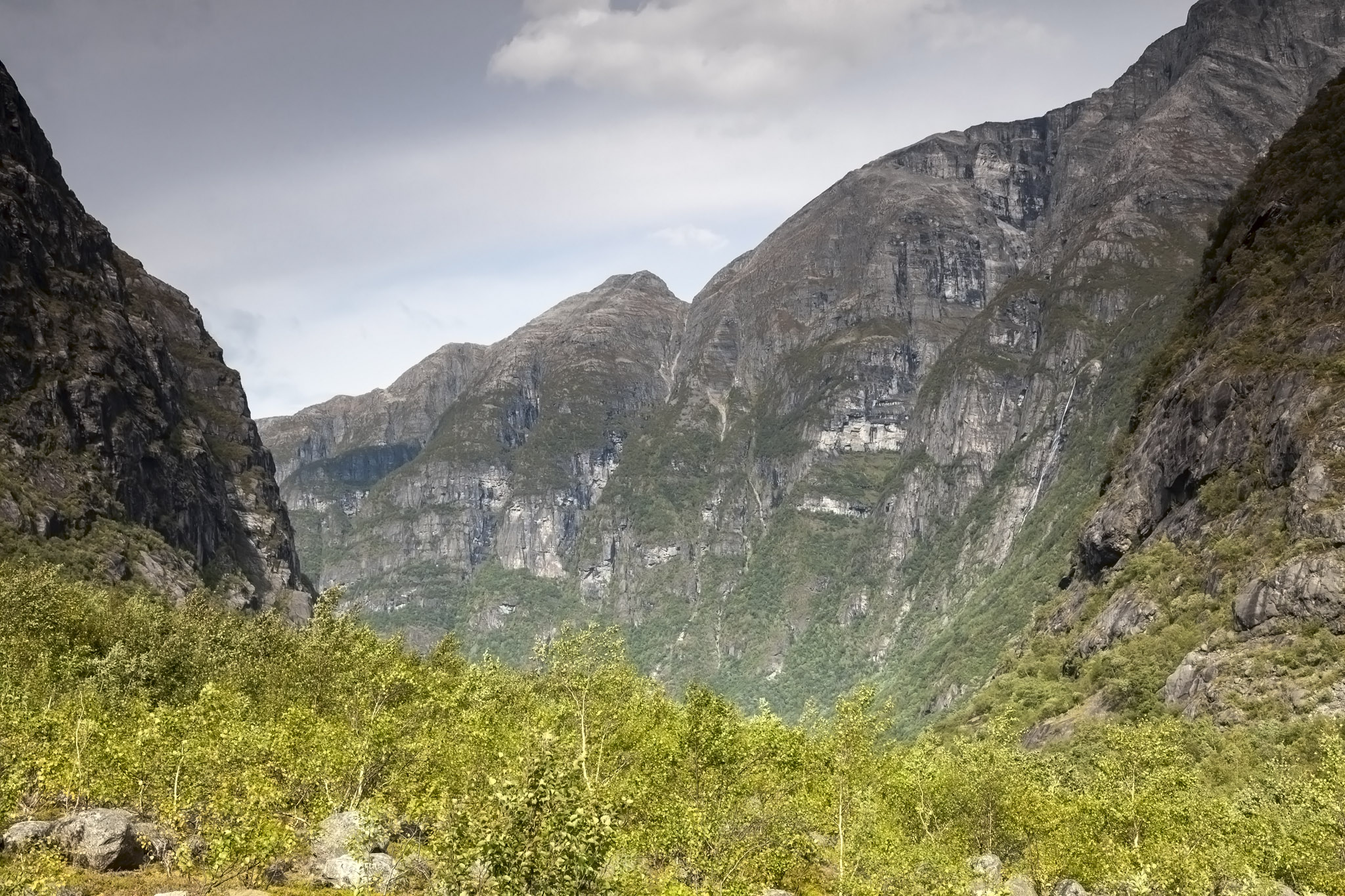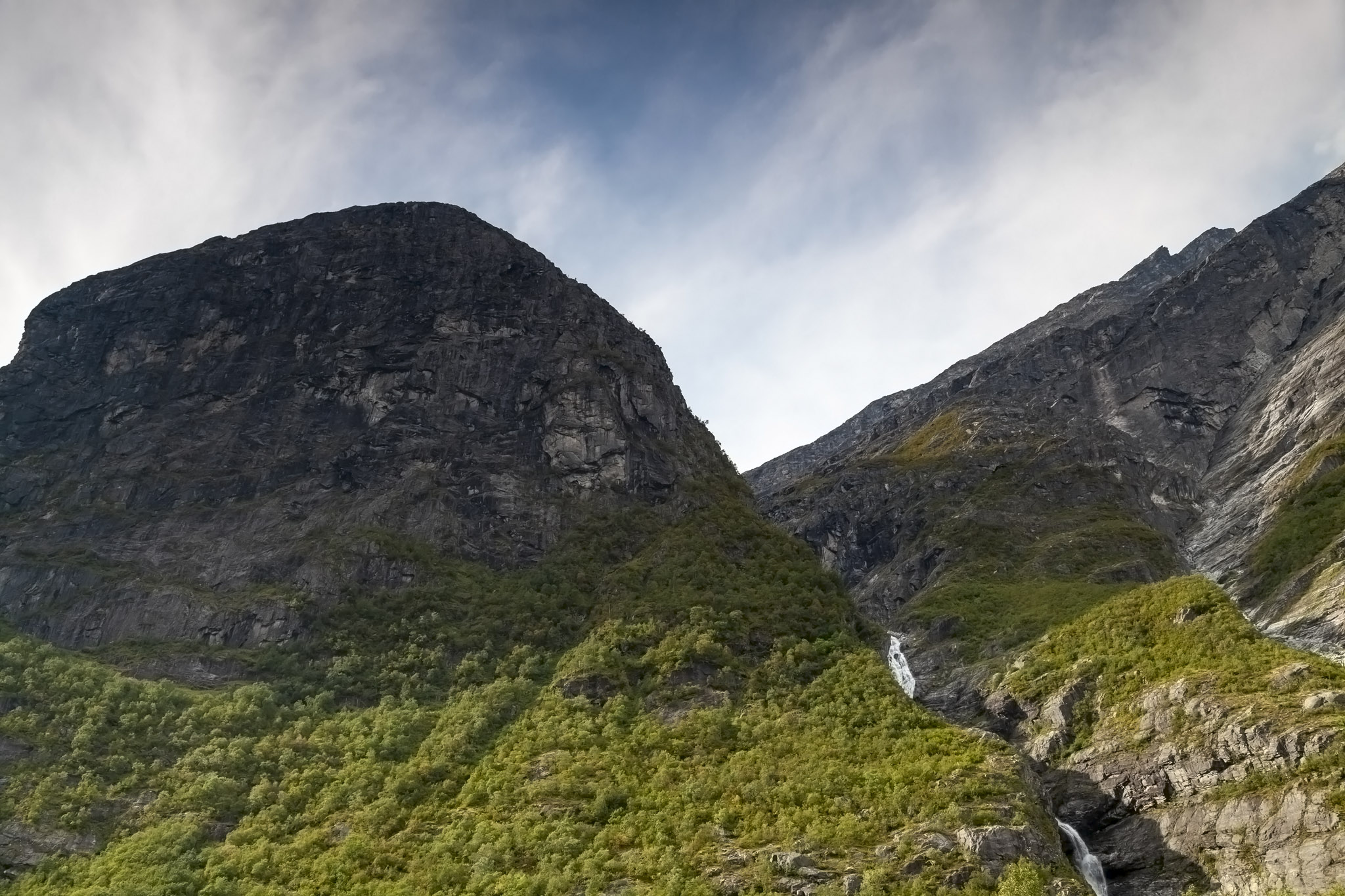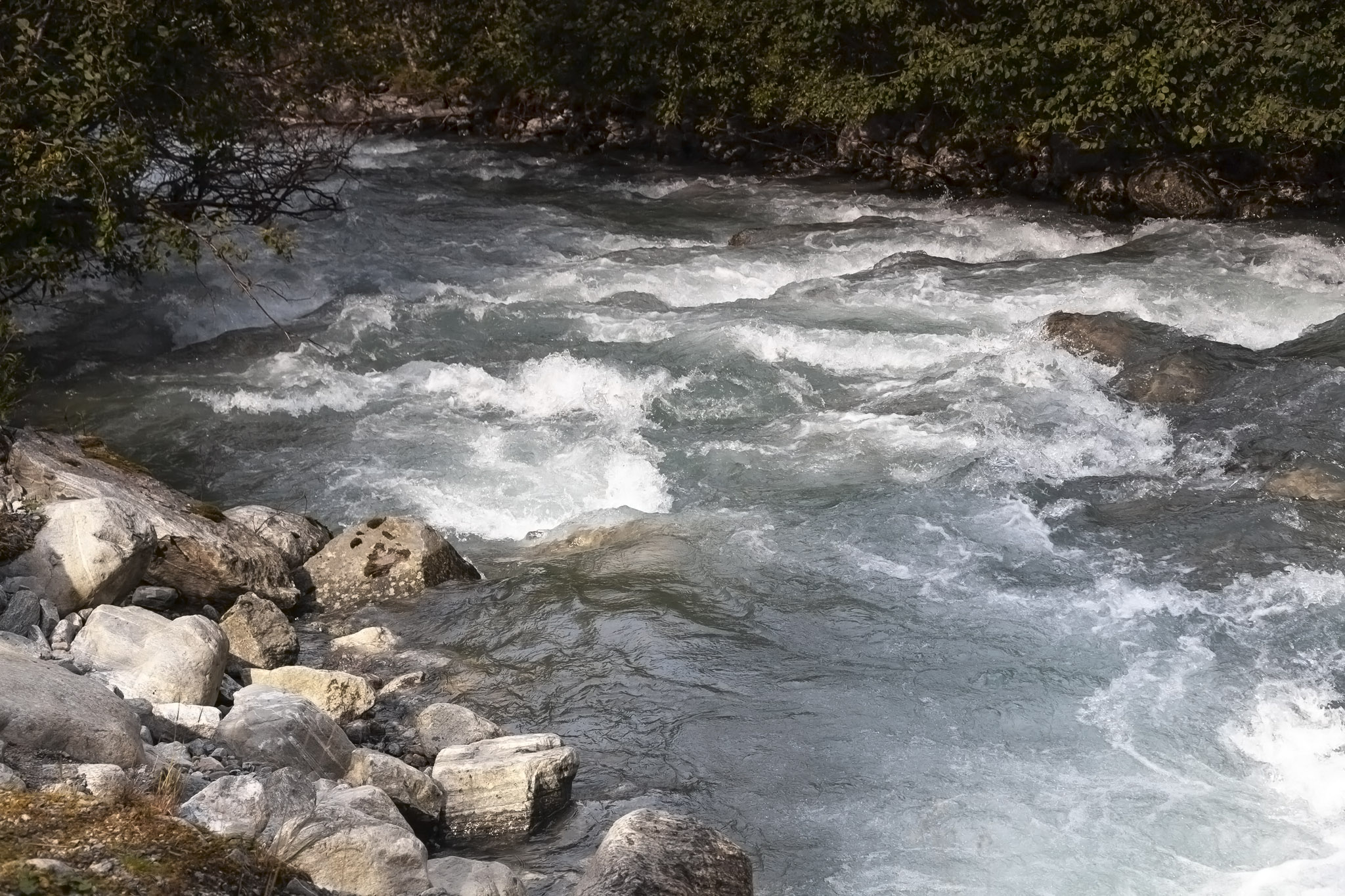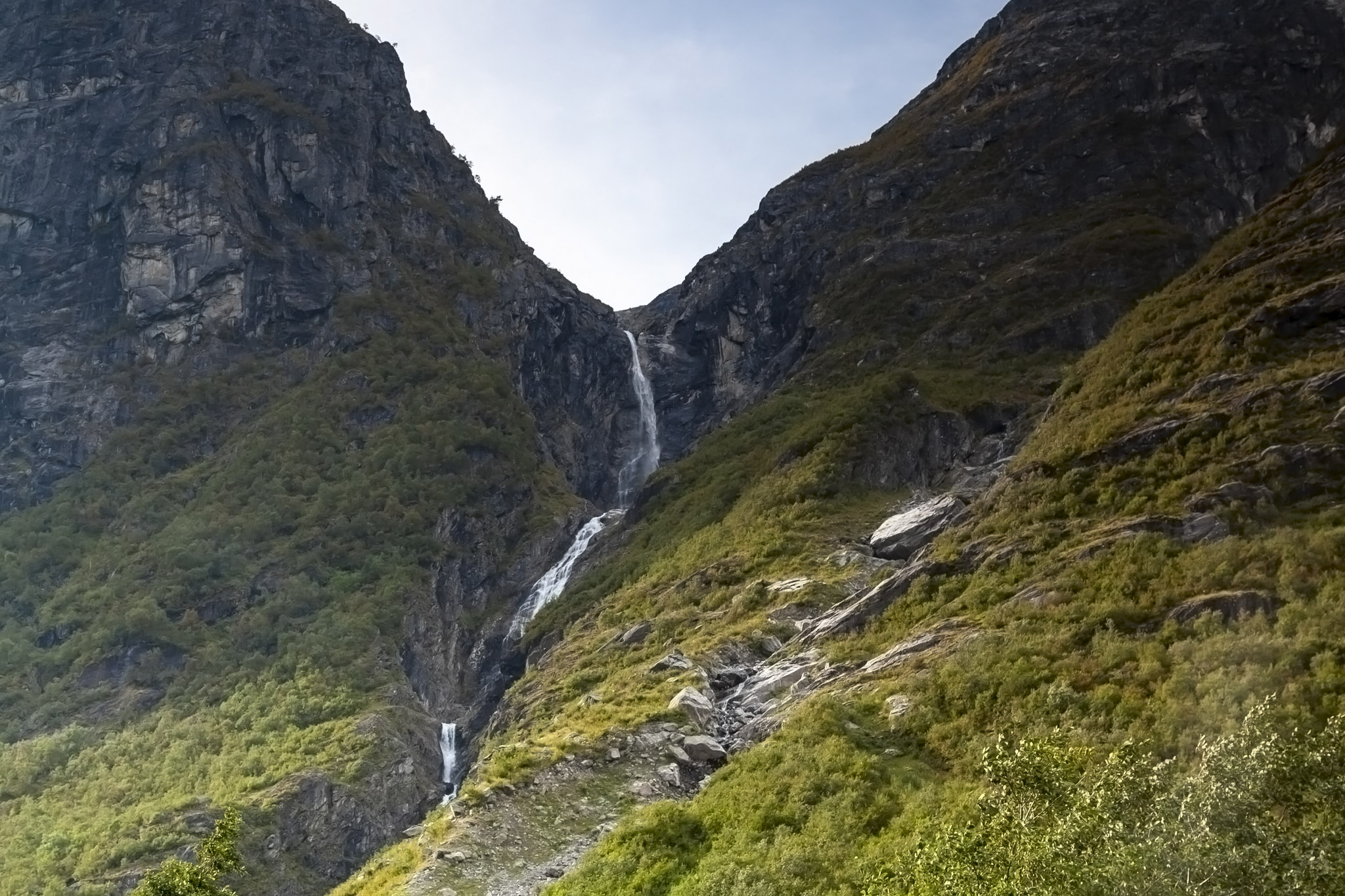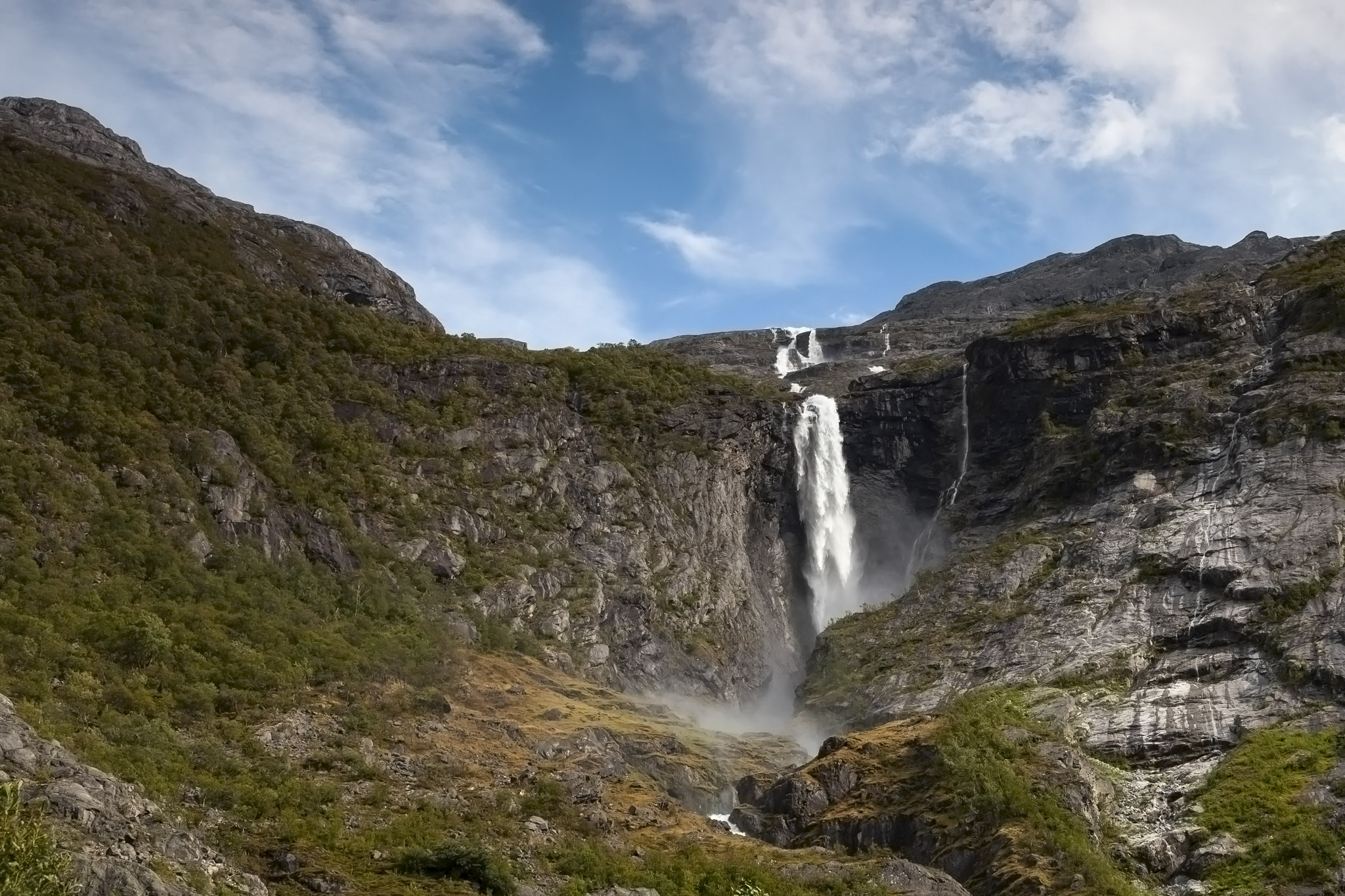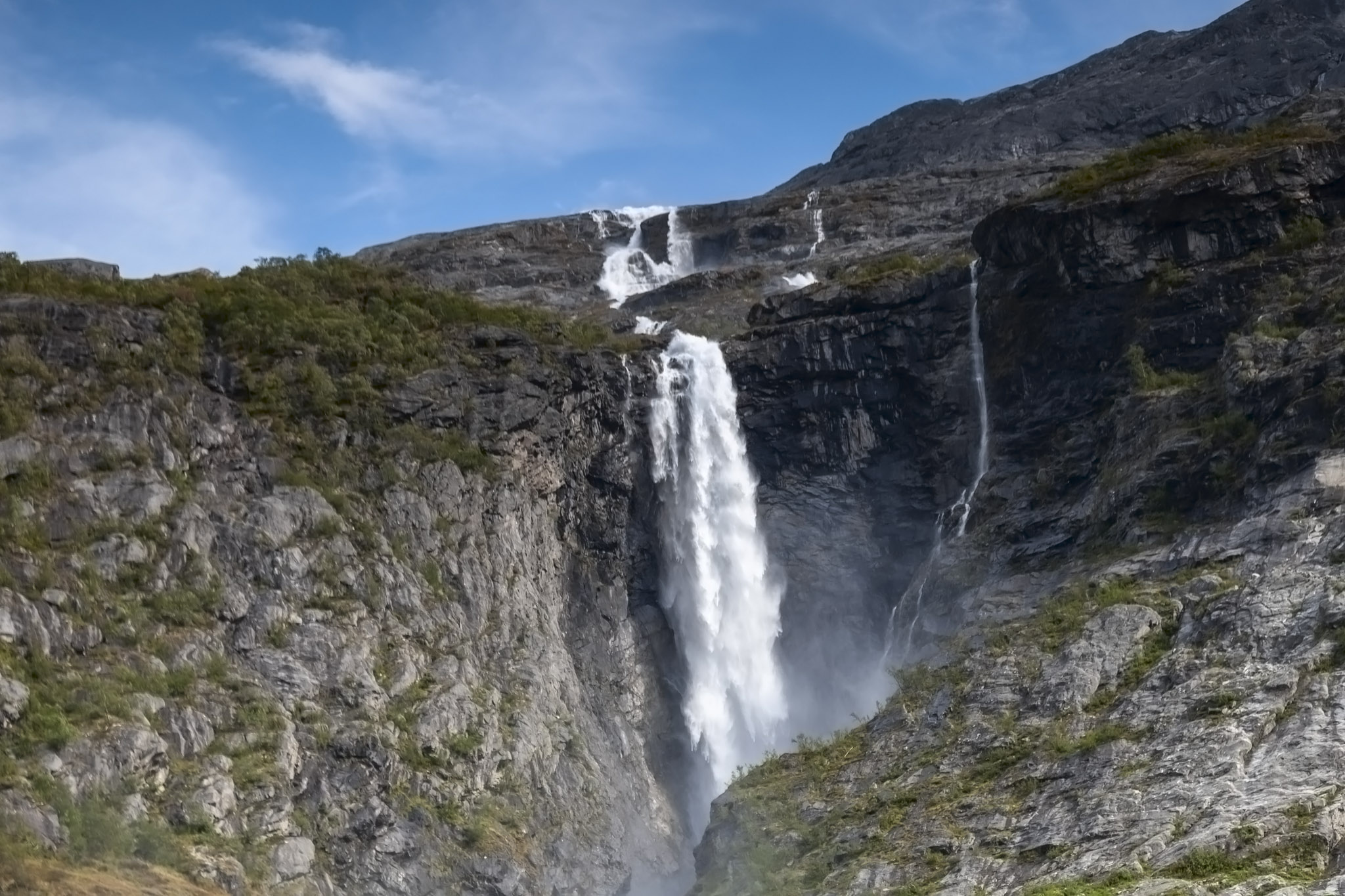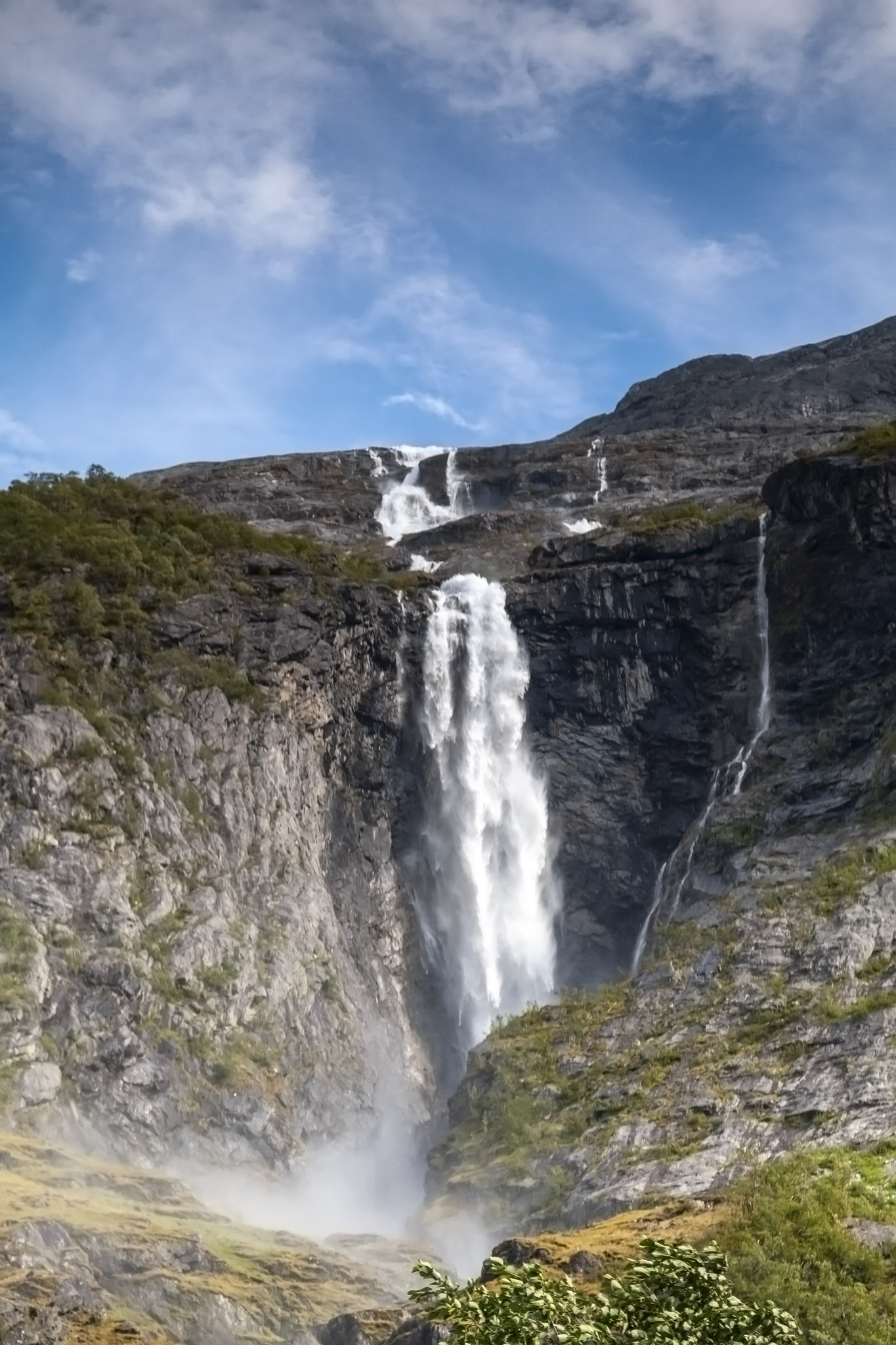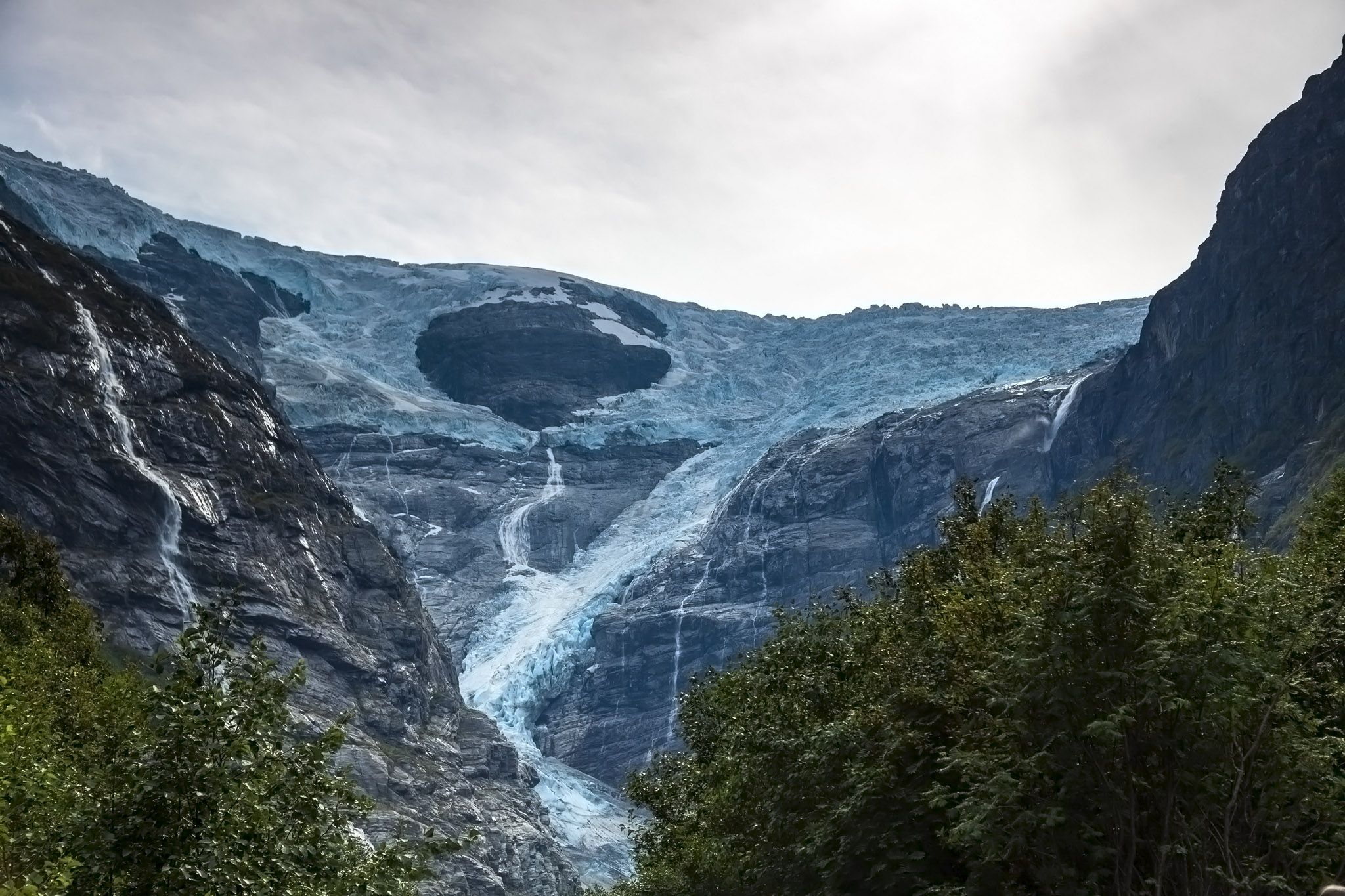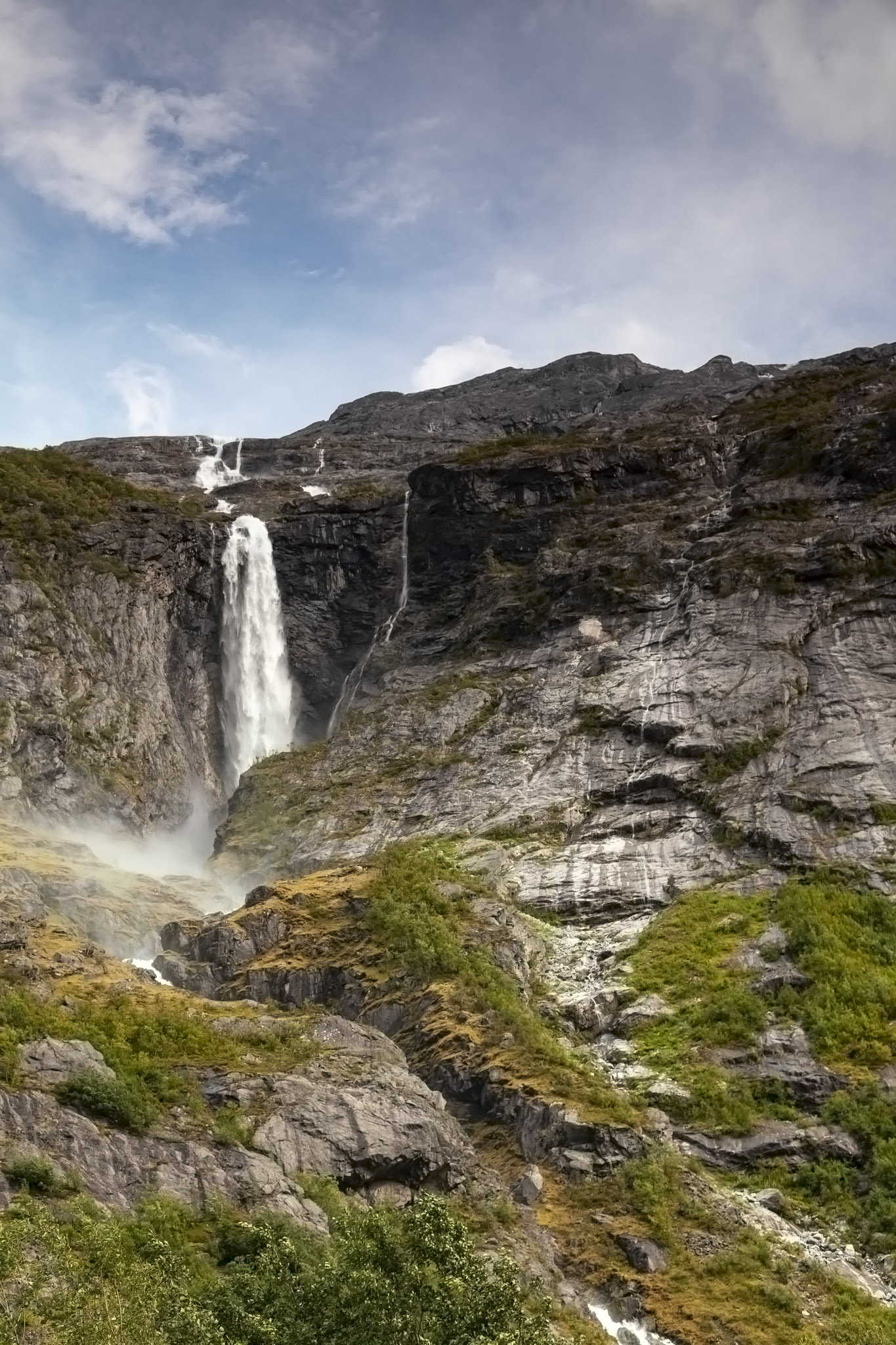Day three of our Norwegian fjords cruise on Crown Princess saw us docked in the port of Olden where we’d arranged an excursion through Princess Cruises.
The bus from alongside Crown Princess took us initially up to Loen, a small village which these days includes a skylift as a popular tourist attraction for those who don’t want to stray too far from where the cruise ships dock. Travelling eastwards from there we drove along the Loelva, the river that connects the Nordfjorden to Lovatnet, a glacier-fed lake, and that would be the first stop on this organised trip.
Our cruise excursion would involve three parts: the first would be a boat trip on the Lovatnet with a snack at the end of that; this would be followed by a visit to a nearby glacier; the day’s activities would conclude with a bus ride back and a stop at a spot with traditional Norwegian buildings. Our boat hadn’t arrived at the lake when we arrived, though, so we had ten or more minutes to stand around and admire the gorgeous scenery in this part of the world.
With the sound of our boat approaching, all of the other passengers on this excursion started to wander back from where they’d been taking a look around. This whole taking a trip abroad thing was still pretty virgin territory for us at the time (there’d been such a long period between our first cruise and this one that we’d effectively reset the clock on it) so we’d stayed close to the bulk of fellow tourists during the wait, not wanting to be those people who stroll off and get lost or cause delays, and even sidled to where we knew the boat would have to stop in order to ensure we couldn’t possibly miss it.
We could see that the boat had seating inside and on top, and with me being the sort of person who likes to take photos of everything (it’s true) I mentioned to my wife that I’d like to head up top for uninterrupted views of the landscape. However, a couple of things scuppered this plan: firstly, there are a lot of selfish people in the world and, without wanting to dip my toes into the waters of stereotyping but being unable to avoid it, the older and whiter and richer American cruising demographic seems to have more than its fair share of them; secondly, I’m introverted (all the time) and polite (when I’m sober). This combination of factors saw our prime position near where the boat was about to tie up get overrun by jostling, careless, more experienced arseholes, and the pair of us shoved away to the back of the queue. We ended up sitting inside.
As it turned out, sitting inside the boat proved to be a positive thing. We could see the people who’d rushed forward and grabbed the outside seating were suffering quite badly with cold, lake spray, and the edge to the temperature in the exposed environment (it wasn’t very windy at all but it wasn’t warm by any means either) was forcing everyone to wrap up as much as possible and bury hands in pockets. It didn’t seem like the best place to take some photographs after all.
Our location in the boat put us close to the water level of the lake and with a window that could be slid open I was able to get some lovely shots of the view ahead and to the starboard side of the vessel.
Our boat trip took around forty minutes and as is the way with excursions we had not only the views to take in but also a running commentary to listen to. This covered geological and historical aspects of the location, and in this particular lake’s case those two aspects were firmly linked. Lovatnet is a glacier-fed lake (actually fed by two glaciers, one of which we’d be visiting next) which accounts for the turquoise colouring, and the surrounding mountainscapes have been prone to landslides in the past.
In 1905 a rockfall triggered tsunamis over forty metres high to travel along the length of Lovatnet. Two villages along the southern shore – Bødal and Nesdal – were hit with the loss of sixty houses, over seventy boats, hundreds of animals, a bridge, and half the population (over sixty deaths). One boat ended up being found three hundred metres inland. A monument was built to honour the dead.
Geologists concluded that such an event was unlikely to happen again so the villages were rebuilt and repopulated but in 1936 a far larger landslide occurred. The tsunamis this time reached a height of over seventy metres, washing away sixteen farms, destroying a hundred houses and other buildings, bridges, a power station, and all the boats. The boat that had previously been deposited three hundred metres inland was moved by the tsunami another one hundred and fifty metres. The 1905 monument was also destroyed, seventy four people lost their lives this time around, and the area was subsequently abandoned.
Our Lovatnet lake boat trip terminated at the southeastern end where a restaurant, Kjenndalstova, was located. This was an opportunity for those who needed to use the restrooms to do so and for everyone to enjoy some waffles. The restaurant itself offers a lot more than just waffles, including trout from the lake, and it’s possible to hire boats to head out and do your own fishing if that’s the sort of thing that floats your boat.
After our snack stop we made our way outside to wait for the bus to arrive and take us on to the next part of the day’s excursion. From Kjenndalstova it’s possible to look across Lovatnet lake and see a pretty impressive waterfall, Ramnefjellsfossen. While its height isn’t known exactly it’s currently considered to be the eleventh highest waterfall in the world.
Time then for the second part of our excursion and the main reason we’d picked this trip, but first an apology.
If you’ve read about our hike in Geiranger from the day before then you’ll already know this and I can only apologise even further for repeating myself. Then again, the likelihood of you having read about our hike in Geiranger from the day before is microscopic because people don’t use the web the way they used to so I feel fully justified in saying this again. Just prior to taking this Norwegian fjords cruise I’d made an impulse buy on the web for some cheap, graduated, neutral density filters as I thought they’d be ideal for getting properly-exposed photos of dark mountains against bright skies. A great theory flawed by not factoring in jagged mountain shapes and choosing the cheapest of cheap options from eBay. The result was dreadfully-exposed pictures with mountains half-under and half-over-exposed, and magenta tones flooding the highlights and shadows. It was also impossible to mount the filter on the lens without leaving a thumbprint somewhere so problems that already existed with a dirty sensor had extra imperfections added to the mix. Anyway, all this is to say that I’m sorry that the photos aren’t better here; I’ve cleaned them up as best I could in limited time and I’ve tried to desaturate the wrong colouring but to do a proper job would take months and the effort’s not worth the result. I’ll just have to go back and take better shots some other day.
Kjenndal Glacier – our destination – is an arm of Jostedal Glacier, which just happens to be the largest glacier in continental Europe. It was also the first glacier we’d ever seen (which, considering this was only our second trip abroad and the first had been to Asia, shouldn’t be that big a surprise). We’ve seen a few more glaciers since then.
There’s not a lot to say about Kjenndalsbreen (its Norwegian name) that you probably can’t guess or that you won’t get told if you see almost any other glacier in the world. The ice is retreating because the world is warming up so if you want to experience glaciers at their most impressive then you need to do it sooner rather than later. Kjenndal’s glacier is actually maintained by snowfall rather than low temperature but that means that any change in climate that alters snow conditions could affect this glacier more quickly than a gradual heat rise over time.
From the point where the bus dropped us off to where we allowed to walk to (we couldn’t get too close to the glacier because the risk of rockfall in the area was too great and the Norwegian authorities sensibly want to keep people a reasonable distance away from natural wonders that are susceptible to tourism damage) was little more than five minutes’ walk and our time in total at this picturesque spot was about forty minutes. This gave us plenty of time to take plenty of photos of the Kjenndal Glacier and the nearby waterfalls cascading over the egdes of the mountains but photography was tricky because the sun was behind the glacier for the most part. Dark rock in the foreground, blue-white ice on the peak, and sunshine diffused through hazy cloud behind was quite a challenge to work with and if you’re keen on taking some great pictures in this part of Norway then take some time to consider where the sunlight’s coming from at the time of day you’re visiting.
You can really get a sense of the difficulty in taking pictures in this video near Kjenndalsbreen, and you’ll also be able to get a sense for how the wind was being funnelled down the canyon leading to the foot of the glacier.
The walk back to the bus took us along a glacial stream. As has already been mentioned, Lovatnet lake is fed by two main glaciers; Jostedal (and its arm here at Kjenndal) being one of them.
While the Ramnefjellsfossen waterfall on Lovatnet had been remarkable because of its height I found the waterfall thundering off the northern face of the rocks near Kjenndal Glacier far more impressive.
With everyone back at the bus on time we then left Kjenndal Glacier behind and started on our return towards Olden where Crown Princess was waiting for us. We wouldn’t be taking the boat along Lovatnet for this as we’d be stopping in a small village along the way and that will be covered in the next post in this cruise travelogue series.








